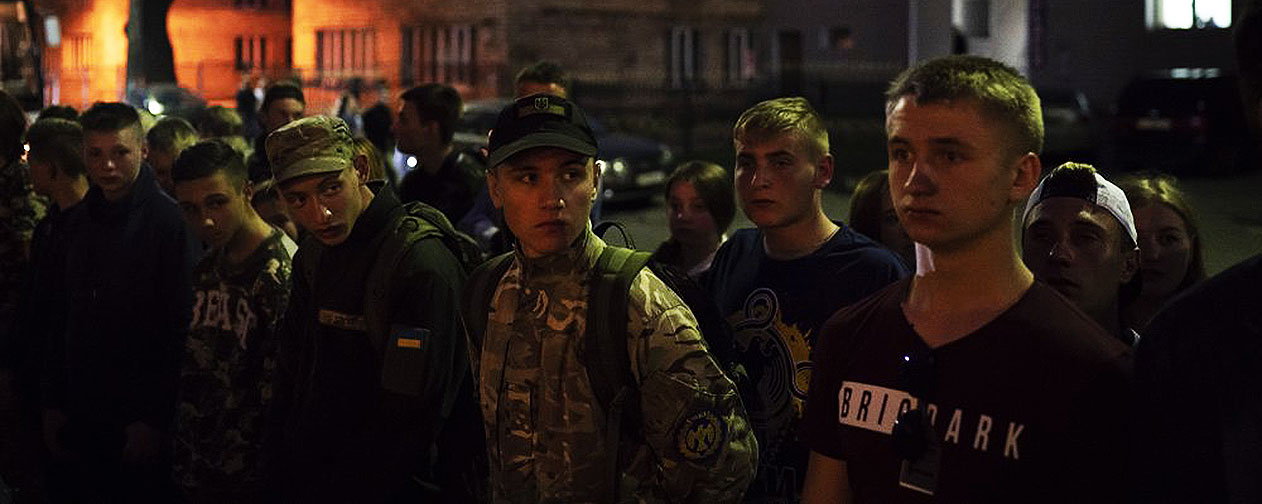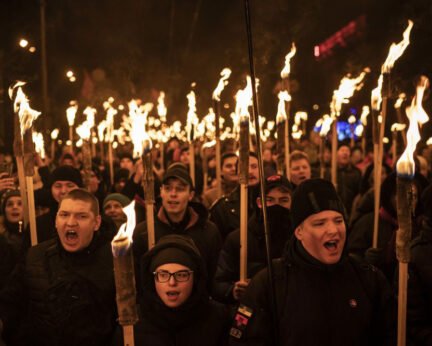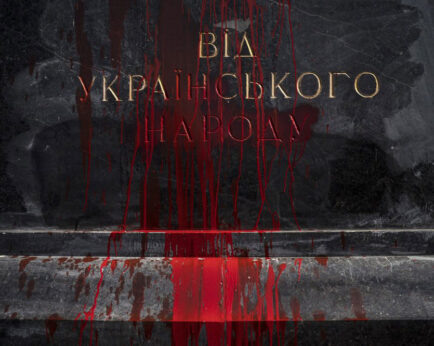
Wars have a way of creating conditions, including eventual major disasters, not always evident when we first enter into them.
With so much weaponry being pumped into Ukraine by the U.S., we can end up actually arming right-wing extremists who are leaving the U.S. to fight with the fascistic Azov Battalion and others against the Russians in Ukraine, where they will gain expertise in using those armaments back here at home.
When finished in Ukraine, they can come home and use the training they got from right-wing extremists over there in their fight against democracy here. It’s not just a danger posed to the U.S. Right-wing extremists from all over Europe are hooking up with their right-wing compatriots in Ukraine and can pose an increased threat to democracy all over that continent.
This wouldn’t be the first time this kind of thing has happened. When the U.S., in order to defeat socialism in Afghanistan, armed right-wing religious fundamentalists to push out the Russians those forces eventually came here to blow up the World Trade Center.
The other more immediate problem of arms getting into the hands of Ukrainian neo-Nazis like the Azov Battalion is that they really don’t care how many Ukrainians die in their fight to impose their nationalistic and fascistic vision on the whole country. They have said openly that if the Ukrainian government makes compromises with the Russians to stop the fighting, they will sabotage those agreements. And there are already forces in the U.S., including the Pentagon, who are more than willing to fight to the last Ukrainian if that is the way to destroy Russia, a country whose wealth they covet.
Since 2014, those extreme right-wing forces have been operating in the Donbas region of Ukraine where they killed 15,000 long before the Russian troops crossed into Ukraine.
On the question of whether Ukraine has a huge problem because of a right-wing extremist network operating within it, we really have to say that it definitely does and that the world ignores it at its own peril. One of the statements made by cheerleaders for U.S. military support for the fight against Russia is that Ukraine is not really a Nazi-run country like Vladimir Putin says it is. The war hawk, former U.S. Ambassador Michael McFaul, leads the charge in that respect. “There are no Nazis in Ukraine,” he has said in interviews, always emphasizing that Ukrainian President Volodymyr Zelensky has a Jewish background.
Both sides in this war, as in every modern war, have their own propaganda machines that interpret existing realities as they see fit. While one can argue that the Russians exaggerate the strength of the neo-Nazis in Ukraine, the U.S., on the other hand, tries to almost pretend that they do not exist. They make claims that only low percentages, 4 percent of voters in Ukraine, have backed them in recent elections so therefore they must not be a threat.
It’s a disingenuous argument because the most powerful of the right wingers, the mass-based Ukrainian Army, the country’s police departments, and the “National Guard,” don’t care about elections and have rarely backed anyone in those elections. Thousands of parents in Ukraine voted for Zelensky on the one hand but send their kids to right-wing training schools where the Azov Battalion and other neo-Nazis teach their children how to shoot Russians. How many of them voted for fascist candidates is not at all a full measure of the influence and power of the extreme right in the country.
Read:
Ukraine’s nationalist youth camps train next generation of fascists
To this day, armed civilians carrying guns from the U.S. shoot Russian-speaking Ukrainians on the streets, declaring them to be saboteurs and collaborators. No trial, no jury, no nothing. Many of those fascistic killers don’t even vote at all.
The Azov Battalion-led forces and other right-wing extremists in the army, acting in the name of the Ukraine government, were so numerous in the east that they were able to kill tens of thousands of Russian-speaking civilians there since 2014. The bloody war Ukrainians everywhere in the country are experiencing now has actually gone on for a long time, with death and destruction coming at the hands not of Russia, but of right-wing Ukrainians.
The West, led by the United States working with Ukrainian allies, has given power to the extreme right in Ukraine, just as they gave power to the right-wing fundamentalists in Afghanistan in the last century. At best, they hoped that by working with the neo-fascists to stage the 2014 coup in Kiev they would be able to seize control of the entire country, making it safe to bring Ukraine into the European Union, which, as it does with its poorer members such as Portugal and Greece, would thoroughly exploit them to the benefit of wealthy capitalists, particularly those in Germany.
The problem with trying to make opportunistic use of fascists to gain economic control over a country is that one often creates Frankenstein monsters.
Adding to this mess created by the U.S. capitalists working with their capitalist allies in Ukraine is the additional mess created by the capitalists in control of Russia when they decided to invade. The Russian action is being used by the extreme right to embolden both their own Ukrainian Nazis and ones coming in from overseas to help them and thereby get the training and experience they want.
What is the reality regarding the extreme right in Ukraine? It is important to understand it so we know how it fits into the disaster currently ongoing in Ukraine and what must be done to establish peace and end the killing.
Ukraine’s neo-Nazi Svoboda Party (Freedom Party) and its founders Oleh Tyahnybok and Andriy Parubiy were key leaders in the U.S.-backed coup in February 2014. U.S. Assistant Secretary of State Nuland and U.S. Ambassador Pyatt mentioned Tyahnybok as one of the leaders they were working with on their infamous leaked phone call before the coup.
What started out as peaceful protests over mostly economic issues in Kiev (Ukraine was then, as it is now, the poorest country in Europe) gave way to pitched battles with police and violent, armed marches to try to break through police barricades and reach the parliament building.
Svoboda rank-and-file and the Pravy Sektor (Right Sector) militia, led by Dmytro Yarosh, battled police, led torchlight marches, and raided police stations for weapons. By mid-February 2014, these armed gangs positioned themselves as the leaders of the Maidan Movement.
Peace and negotiation were never given a chance. The Minsk Agreement, a negotiated settlement worked out by Ukrainian moderates, Belarus, France, Germany, and Poland was ignored. The U.S.- backed violent neo-fascists took over.
It was Yarosh, backed by the U.S., who took over as the public leader of the Maidan and rejected the Feb. 21, 2014, deal negotiated by the French, German, and Polish foreign ministers, under which Viktor Yanukovich, the democratically-elected president of Ukraine, and opposition political leaders agreed to hold new elections later that year. Instead, Yarosh and Right Sector not only did not give up weapons but instead led a march on parliament and overthrew the government. It was a successful version of what would happen years later on Jan. 6 in the attack on the U.S. Capitol, only it was actually backed by the U.S. government.
Since 1991, the year the Soviet Union was dismantled, Ukrainian elections had swung back and forth between leaders like Yanukovych, who was from Donetsk and had close ties with Russia, and Western-backed leaders like President Yushchenko, who was elected in 2005 after the “Orange Revolution” that followed a disputed election.
Deep corruption was a feature of every one of the Ukrainian governments, essentially run by one group or another of corrupt capitalists who busied themselves, like their counterparts in Russia, privatizing public property won by the hard work of the working people during the socialist years and enriching a handful of oligarchs.

In 2014, Nuland and the U.S. State Department got Arseny Yatsenuk installed as Prime Minister of the post-coup government. He lasted only two years, until he, too, lost his job due to sensational corruption scandals. Petro Poroshenko, the post-coup president, remained in office until 2019, even after his personal tax evasion schemes were exposed in the 2016 Panama Papers and 2017 Paradise Papers.
When Yatsenyuk became Prime Minister, to please the fascists and reward them for the coup, he gave Svoboda three top Cabinet positions, including Oleksander Sych as Deputy Prime Minister and governorships of three of Ukraine’s 25 provinces. Svoboda’s Andriy Parubiy was appointed Chairman (or speaker) of parliament, a post he held for the next five years.
After the coup, the Right Sector helped to consolidate the new order by attacking and breaking up anti-coup protests, in what their leader Yarosh described to the Western press as a “war” to “cleanse the country” of pro-Russian protesters. This campaign included on May 2 a massacre of 42 anti-coup protesters and trade unionists in Odessa after they hid from Right Sector attackers in the Trades Unions House in that city. The neo-Nazis set the building on fire after they locked everyone in. When people jumped out of windows to save their lives, the right-wing mobs beat and set them on fire as they landed on the ground outside.

After the moves toward separation in Donetsk and Lugansk, the neo-Nazis in Ukraine mounted full-scale military operations, killing 15,000 in the east. They were sent in because many of the rank-and-file in the Ukrainian Army did not want to kill those they regarded as their own people. The neo-Nazis came in handy for a Ukrainian government looking for soldiers to wage their war against the people in the breakaway regions.
The way this was done was to set up so called “National Guard” units which were, in reality, fronts for the neo-Nazis. Right Sector also formed units, as did the Azov Battalion, which was founded by Andriy Biletski.
The Azov Battalion is an admitted white supremacist group that says openly its purpose is to rid Ukraine of Jews and other “inferior” races. It was this group that actually took the city of Mariupol back from the separatists. We know, of course, what has happened to that city now.
The Minsk II agreement in 2015 set up a zone around the breakaway republics in which it was agreed there would be no fighting. The fighting continued, however, although it was less intense as the years went on.
The media has mostly ignored efforts in the U.S. to curtail support for the Ukrainian right wingers. Democratic Rep. Ro Khanna of California and other members of the Progressive Caucus pushed for years to end U.S. military aid to the Azov Battalion. They finally did so in the 2018 Defense Appropriation Bill, but somehow the Pentagon has managed to continue the aid, nevertheless. (That is material for another Iran-Contra Affair type story.)
Anti-terrorist groups have also been keeping their eye on the Ukrainian extreme right, warning that they are networking around the world.
The Soufan Center, which tracks terrorist groups, said in 2019, “The Azov Battalion is emerging as a critical node in the transnational right-wing violent extremist network… (Its) aggressive approach to networking serves one of the Azov Battalion’s overarching objectives, to transform areas under its control in Ukraine into the primary hub for transnational white supremacy.”
The group described how the Azov Battalion’s “aggressive networking” reaches around the world to recruit fighters and spread its white supremacist ideology. Foreign fighters who train and fight with the Azov Battalion then return to their own countries to apply what they have learned and recruit others.
Brenton Tarrant, who massacred 51 worshipers at a mosque in Christchurch in New Zealand in 2019, and several members of the U.S. “Rise Above Movement” who were prosecuted for attacking counter-protesters at the “Unite the Right” rally in Charlottesville in August 2017, have been trained by the Azov Battalion.
Neo-Nazi groups have maintained much of their power on the street in Ukraine, and in local politics in the nationalist-leaning areas of Ukraine, particularly around Lvov in the West.
Zelensky himself had run for election as a “peace candidate,” but under threat from the right, he refused to even talk to Donbas leaders, whom he called terrorists. The right wingers threatened him with death if he dared implement the terms of the Minsk Accords, which laid out a basis for peace and could have prevented the current war.
During Trump’s presidency, the United States reversed Obama’s ban on weapons sales to Ukraine, and Zelensky’s warlike pronouncements, doubtlessly encouraged by right-wing threats against him, actually raised concern in Donbas that the Ukrainian government was planning an offensive to retake their area.
A major factor feeding the extreme right in Ukraine, however, goes well beyond the long war in the east. The right-wing neoliberal policies of the government are also to blame. The post-coup government imposed “shock therapy” to bring capitalism to power in a post socialist society.
Ukraine received a $40 billion bailout from the International Monetary Fund and, as part of the deal, privatized 342 state-owned enterprises, reduced public sector employment by 20%, along with salary and pension cuts, privatized healthcare, and disinvested in public education, closing 60% of its universities.
Ukrainian capitalists looted public and state assets, and living standards plummeted, making the country Europe’s poorest. The right wing fed off this discontent, too.
The disasters of neoliberalism are clearly the driving force behind right-wing extremism, militarism, and fascism, not just in Ukraine but everywhere else in the world. Those disasters are among the leading threats to peace and security everywhere. Expect that sooner or later the U.S. support for the right wing in Ukraine will come back to haunt us.
As with many news, analytical, and op-ed articles published by People’s World, the opinions represented here are solely those of the author.










